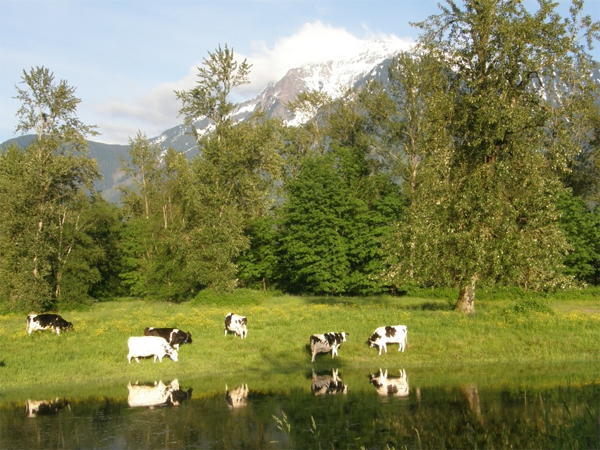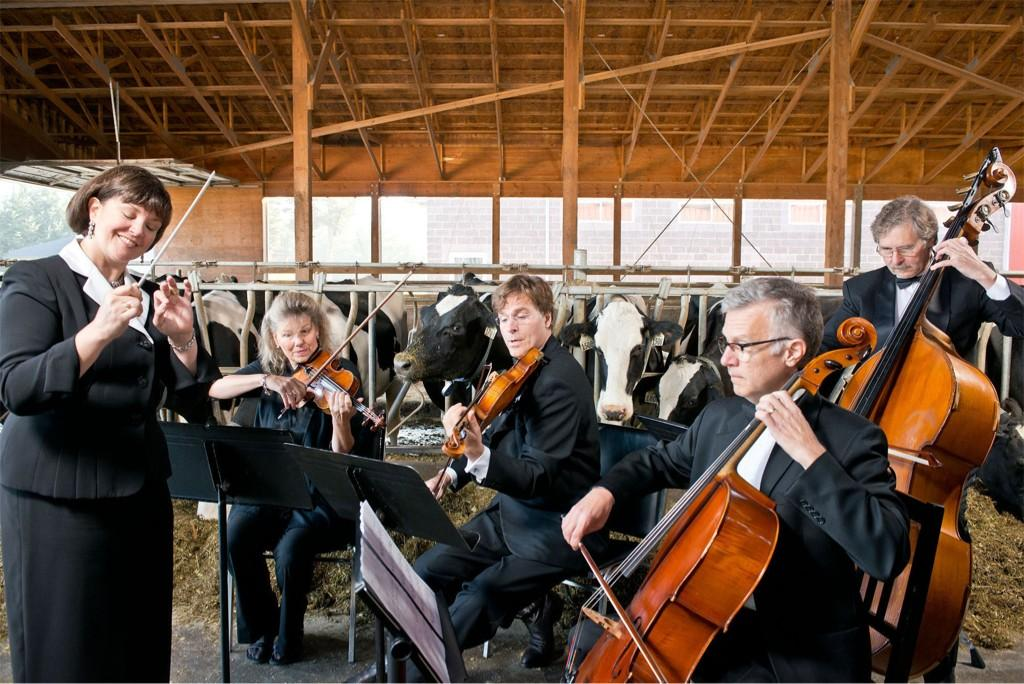Valedoorn Farm in British Columbia’s Fraser Valley is a family farm. Tom Hoogendoorn is proud of that designation and how it motivates their family’s business philosophy. “We put a great deal of effort into quality of life for our families and employees.”
This passionate dairy ambassador is set to share his enthusiasm and expertise as a panelist at the 2nd annual Canadian Dairy Xpo in Stratford, Ontario on Thursday, February 6th. If you’re looking for a “day off” this is the exact place to get recharged and revitalized for the year ahead. Building on the resounding success of last year’s inaugural event, Canadian Dairy Xpo 2014 organizers have put together a tremendous diversity of products, experts and entertainment in one place at one time (Check out the full Canadian Dairy Expo program).
This Family is Positive about Moving Forward
Tom and Gail Hoogendoorn own Valedoorn Farm with Tom’s brother John and his wife Lan. For the Hoogendoorn brothers it was a logical progression. “My brother and I were born into the dairy industry. Our father died while we were still in high school. At that time I was 17 and John 15 and we worked on the farm with our mother from 1979 till 1987 when we purchased it. We have slowly expanded our land base from 47 to 200 acres and rent another 110 acres making corn and grass silage and currently have 260 cows and 260 young stock. We employ 3 fulltime staff including my nephew Alex. We also have several part time staff.” The sadness that touched their family in the end has had a positive effect on how they live their dairy lifestyle. “Having our father die early made us realize that every day should be meaningful and enjoyable if possible.”
Optimal Care. Optimal Efficiency. Open Doors.
High standards are also applied to every area of the dairy operation. All of the Valedoorn cattle are registered and classified. “We optimize efficiency in every area of our farm whether it is getting heifers pregnant or getting the most out of our crops.” The benchmarks they have reached record their success at targeting measureable goals. “Currently BCA’s run between 245 to 255. Pregnancy rate runs around 30 percent year over year. We ask our cows to milk a lot of milk but try not to push the grain too hard relying on our forages to do the job.” There are many fine details of cow management that must be optimized and when it comes to herd health, they can truly be said to be aiming to put their best foot forward. “Hoof care is a huge part of our management practice. We want our cows walking comfortably and happily to the feed bunk! This is huge!”They also ask a high level of commitment from themselves and staff. The doors are open to everyone. “We have a modern dairy setup that is camera or visitor ready every day or night. This “open door” policy is opening minds too as people come to Valedoorn. “People are always very surprised on how well the animals get treated.”¦It’s a real eye opener, when they come to the farm, to see how clean it is. We’re really proud of that fact and that’s why we never turn tours away.”
Both Cows and Bulls Must Meet Strategic Performance Parameters
The philosophy of consistent improvement also applies to the dairy genetics of the Valedoorn herd. “Our breeding goals are to have every cow classify 80 pts or higher. We want average sized cows with a will to work standing on great feet and legs with pleasing udders. This has resulted in 75 percent GP or better with us having bred 5 Excellent cows in the last number of years including a Throne who just calved for the 8th time who is 5E 92 Pts. We love good cows who give us no trouble. We work with Alta and Derek Flaman who picks the parameters and chooses the bulls. All breeding is done with their breeding guide. We do use some sexed on heifers and choose bulls for health traits udders and legs. We also like dairy strength.”

The view from Tom’s kitchen window
Canadian Dairy Farming from the Global and Local Perspectives
Tom`s interest in dairy farming spans local, national and international issues. Locally Valedoorn must always be alert to changing pressures. ““Challenges currently facing me are getting enough land in our area to farm and the start of succession planning. In Canadian terms he recognizes the unique challenges. “Dairy farming in Canada is different than other parts because of quotas. We are well organized as an industry and can affect change for our own well being. That is a two edged sword as it sometimes breeds complacency and an attitude of entitlement. We have to work hard to keep our system and be responsive to consumer demands. In the industry it’s trying to keep our Supply Management system whole and working for every farmer large and small in every region.”
RELATIONSHIPS: Run the Business. Grow the Business. Transform the Business.
The first priority and one that’s harder and harder to meet is a personal one, “For me it’s getting enough time to spend with the family.” Having said that Tom acknowledges that all the time spent is a main reason that the family farm has been in the family for 34 years. “That’s a great accomplishment arising from constantly expanding our land, cows, quota, and barns.” The family, the farm and the business is constantly changing with three main priorities. “The family working together. We are always meeting the goals we set. We continually set new goals to move us forward.”
Tom has seen many changes in the dairy industry and it has affected his approach to dairying. “Over the years the biggest change has been the size and efficiency of the farms. All our practices and methods are improving at least in the Fraser Valley where I live.” Looking back he is amazed at the progress. “There is a huge change in the quality of our cattle and the efficiency of our farms. It would have been unthinkable 30 years ago.” Once change that Valedoorn farms embraces is genomics. “Genomics for us mean better faster genetic improvement. Simple story. We are getting more info on cattle sooner and can use that for faster improvement. “
The proAction Initiative
Tom doesn’t shy away from the issues impacting the dairy industry. “We must acknowledge that the consumer and government are trying to get more involved with how we produce food in this country. We can’t ignore their questions and expect support from the broad public. People are curious about food since they are getting more and more removed from rural and farm life.” This has led to Tom becoming a spokesperson for exactly those concerns. The proAction Initiative is a way of showing our customers and consumers that we have improved the management of our farms over time. That we take responsibility for our on farm food safety, quality of milk, care of our animals, and care of the environment. We are doing things to enhance biosecurity to limit or prevent diseases from coming onto our farms. It’s going to be a way of not only telling our consumers that we are doing a good job but we will have a way of measuring and proving that claim. It will be a way of defending our best practices that we are implementing on our farms. Showing is better than just telling all the great things we as Canadian dairy farmers are doing in the area of sustainability.”

Classical music being played for the cows at Tom’s farm for the website musicmakesmoremilk.com
Opportunities Ahead. Raise Awareness. Hold office.
Tom encourages and in fact urges all farmers to get more personally involved and suggests that communication is the first step. “Farmers should be involved in social media just as they should be involved in their communities. It raises awareness and profile of our industry and hopefully creates a positive link to our consumers. Farmers can no longer sit at home thinking a few select people will move them forward. I always urge frustrated young farmers to organize and get involved and take a run at leadership in whatever form they think they may be effective or like.”
Tom endorses all forms of communication, including digital and once again doesn’t expect others to do something he doesn’t do himself. “Social media for me started as a way to connect with the running world. I run marathons and so on for a hobby and it was a good way to learn and interact. Soon I learned that it is a good tool for farmers to tell our story as long as it is done properly. While I was a Dairy Farmers of Canada board member, I started concentrating on that side of it. Social media for me has been a fun positive experience. You get out what you put in as most things in life.”
The Bullvine Bottom Line
Tom Hoogendoorn is fully aware that there are many different ways for farmers to set and meet goals whether it’s running a dairy operation or running a marathon. However, there is one characteristic that he urges everyone to embrace. “Never stop changing.” For Valedoorn Farm and the Hoogendoorn family that means working to move forward. Tom hopes your forward looking plans include Canadian Dairy Xpo. If you do nothing more than find an answer to a problem you’re working on or a make a new contact or get an onsite review of a piece of equipment, Canadian Dairy Xpo might solve or begin to solve your biggest dairy challenge and that means you will be move forward in 2014. Catch Tom Hoogendoorn`s enthusiasm and you could go home from your “day off” with a solution that`s “right on!”
Want to learn more about Toma nd the proAction Initiative? Tom will be presenting at Canadian Dairy Expo on February 6th.








 The US Situation
The US Situation The Canadian Story
The Canadian Story




